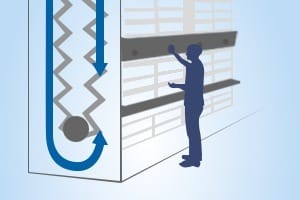What is a paternoster or carousel storage system?
Paternoster or carousel storage system: not only in demand as an elevator, but also ideal for storing small parts
Anyone who took a step into offices or administrative buildings in the 1980s or 1990s will be familiar with the so-called paternoster elevator. The paternoster is a classic passenger circulating elevator, typically accommodating up to two people per cabin. The special feature of this elevator system is the fact that the individual cabins (suspended on chains) can be controlled in continuous rotation. One and the same elevator cabin constantly switches between two elevator shafts by means of turning point pulleys – it goes up and then down again in the other shaft.
What does the paternoster have to do with intralogistics? Quite a lot, as proLogistik will explain in more detail. But first, let’s take a look at the basics of the paternoster elevator before we explain the logistical components.
Basics explained simply: paternoster as a passenger elevator
The term as such is derived from Latin and means “our father”. Over time, it was mainly used by miners to describe circular elevators, which are similar to rosary beads in their arrangement. The paternoster elevator is designed such that people can travel quickly across individual floors in both directions without having to wait. A look at the transportation speed per person in particular makes it clear why this principle was increasingly used in public buildings, especially in the post-war years.
However, paternoster elevators were only put into operation in West Germany until 1974, and only around 200 paternosters still exist in Germany due to fire safety regulations and other rules. However, the principle is ideal for handling small parts, as we will explain in more detail in the next section.
The paternoster storage system: a vertical carousel for maximum performance in a limited space
A circulating storage system in the form of a paternoster is particularly popular for small parts warehouses, as the advantages are obvious. On the one hand, space can be optimally utilized by building “upwards”. Vertical shelves are designed such that various small parts can be stored here to save space. On the other hand, the warehouse clerk’s search time is reduced to a minimum, and the goods-to-person principle has completely eliminated travel times.
Shelving systems such as the paternoster can be tailored to the specific needs of the company, for example specifically for card index boxes or as a tiered paternoster for dispatch handling. It would also be conceivable to design the rail guide horizontally (so-called silo paternoster) in order to fully utilize storage space as far as possible.
Note: A paternoster warehouse is based on the goods-to-person principle and facilitates the picking of small parts, which are made accessible quickly and compactly via so-called removal openings. It enables efficient, directly controllable storage, guarantees a high circulation speed and increases the storage area even where space is limited.
Structure of a paternoster warehouse
To give you a better idea of how a paternoster works, let’s take a closer look at the structure of this carousel system. The particular advantage is that an individual design to meet the requirements of the bearing is possible in practically every case. Individual, customer-specific solutions can therefore be realized at any time.
The most important aspects of paternoster storage:
- The basic principle is based on the paternoster elevator; the stored goods are delivered directly to the operator (goods-to-person principle), not the other way round.
- Vertically arranged, all-round shelves can be loaded and unloaded with goods via an easily accessible operating window. Each storage compartment is given a unique number and rotates within the closed system.
- The paternoster can be used with open-fronted storage containers to efficiently handle small parts via small parts containers, for example. They can be stored loose and without packaging.
Important: a paternoster storage system as a carousel storage system cannot be extended at will. This is due to the rigid outer shell. However, the inner workings of the storage system can be optimized, for example to increase picking performance on the basis of a higher circulation speed. Warehouse management based on the FIFO principle (“first in, first out”) and the LIFO principle (“last in, first out”) can be implemented with a paternoster-style carousel.

